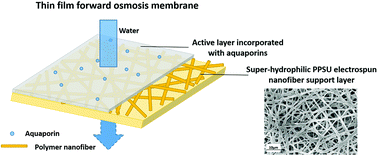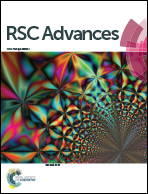Preparation of super-hydrophilic polyphenylsulfone nanofiber membranes for water treatment†
Abstract
Electrospun nanofiber membrane-supported thin film composite (TFC) membranes exhibit great potential in water purification. In this work, electrospun polyphenylsulfone (PPSU) nanofiber membranes were prepared and modified by heat and plasma treatments. The resulting membranes were used as support layers for biomimetic TFC-based forward osmosis membranes. Thermal treatment transformed a loose non-woven nanofiber structure into a robust interconnected 3-dimensional PPSU network displaying a 930% increase in elastic modulus, 853% increase in maximum stress, and two-fold increase in breaking strain. Superior hydrophilicity of PPSU nanofiber membranes was achieved by low-pressure plasma treatment, changing the contact angle from 137° to 0°. The fabricated exemplary TFC-based forward osmosis membrane showed an osmotic water flux Jw > 14 L m−2 h−1 with a very low reserve salt flux Js (Js/Jw = 0.08 g L−1) demonstrating the potential for making high quality membranes for water treatment using PPSU-based support layers for TFC membranes.



 Please wait while we load your content...
Please wait while we load your content...